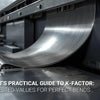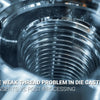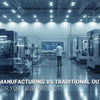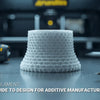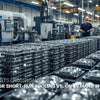Food-Grade PEEK Coffee Grinder Parts: Why Top Manufacturers Are Making The Switch?
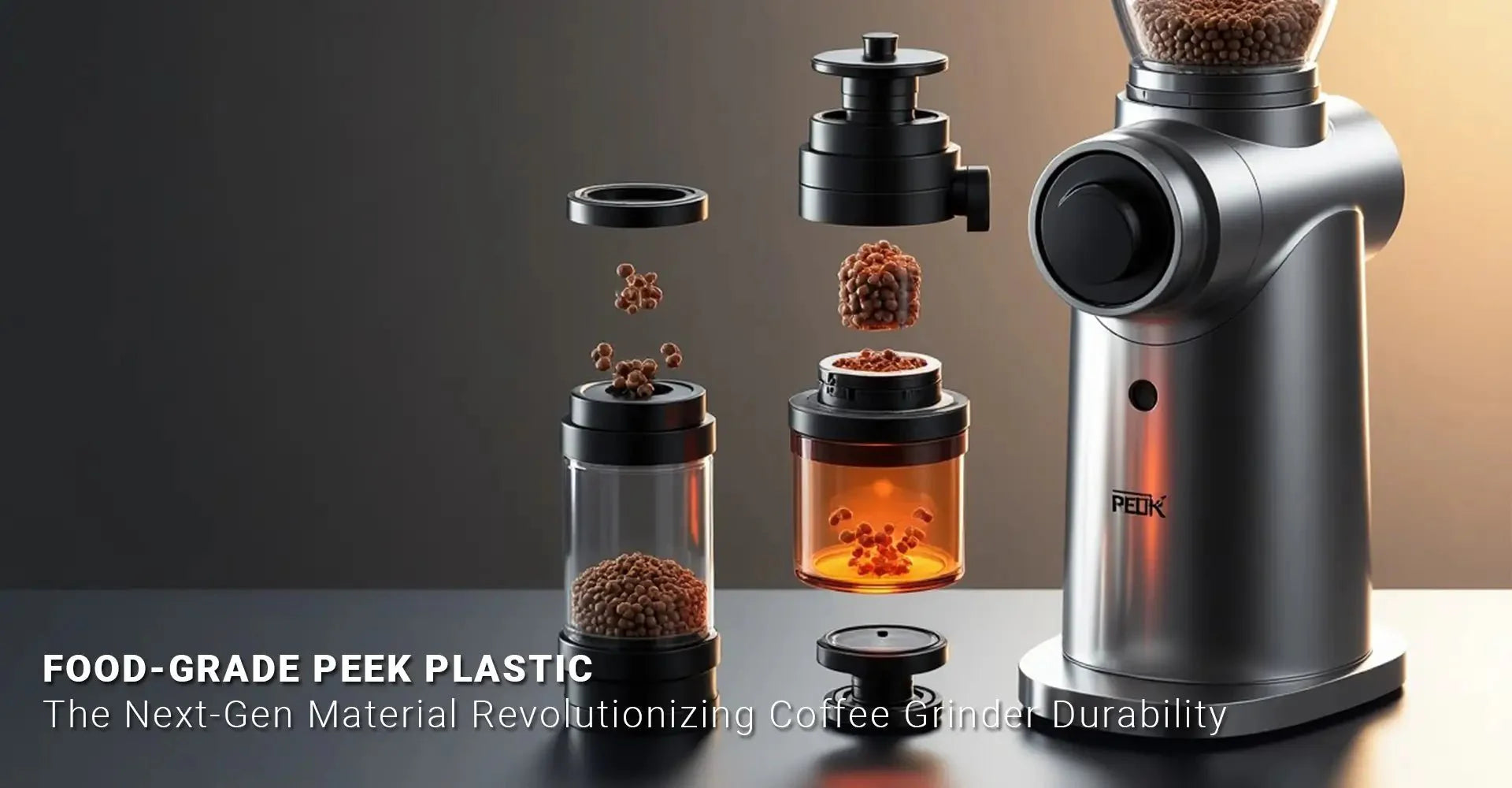
Food-Grade PEEK Coffee Grinder Parts: Why Top Manufacturers Are Making The Switch?

The specialty coffee industry faces constant challenges in developing equipment that balances performance, durability, and food safety. In recent years, a growing number of premium coffee grinder manufacturers have quietly adopted a game-changing material: food-grade PEEK coffee grinder parts. This advanced polymer is dramatically extending component lifespan while maintaining exceptional food safety standards that meet both commercial and consumer demands.
Food-grade PEEK offers coffee equipment manufacturers a unique combination of heat resistance up to 250°C, superior wear resistance with <0.1% mass loss after 10,000 cycles (compared to ceramic's 0.5%), and full FDA compliance - all while potentially reducing long-term maintenance costs by up to 70% compared to traditional materials. Furthermore, this remarkable plastic has become the go-to choice for manufacturers seeking to enhance their coffee equipment performance.
As coffee grinding technology advances, the limitations of traditional materials like stainless steel, aluminum, and ceramic are becoming increasingly apparent. Let's examine why high-temperature resistance PEEK plastic for appliances is emerging as the material of choice for forward-thinking coffee equipment manufacturers looking to enhance durability without compromising safety or performance.
Table of Contents
- Why Does PEEK Outperform Stainless Steel in High-Temperature Coffee Grinding?
- How Do PEEK Components Compare to Ceramic Burrs in Wear Testing?
- What Makes PEEK the Top Choice for Food Safety Compliance?
- Can PEEK Really Extend Coffee Grinder Component Lifespan?
- When Does Investing in PEEK Components Make Financial Sense?
- Which Cleaning Methods Work Best with PEEK Coffee Components?
Why Does PEEK Outperform Stainless Steel in High-Temperature Coffee Grinding?
The heat generated during intensive coffee grinding can create significant challenges for equipment durability. When comparing wear-resistant PEEK vs stainless steel coffee grinders, the difference becomes immediately apparent at high temperatures. While stainless steel begins to experience warping risks at temperatures around 150°C, PEEK maintains its structural integrity at temperatures exceeding 250°C.
The heat deflection temperature of food-safe plastics varies widely, but PEEK stands apart with its exceptional thermal stability. This remarkable property ensures that PEEK components remain dimensionally stable even under the intense friction-generated heat of commercial grinding operations, where temperatures can frequently spike beyond what metals can reliably handle.
The molecular structure of PEEK creates a unique combination of thermal resistance and mechanical strength that metals simply cannot match. When selecting materials for CNC metals and plastics manufacturing, engineers increasingly recognize that PEEK's thermal properties translate to real-world benefits: reduced thermal expansion, consistent performance across temperature fluctuations, and elimination of heat-related deformation that can affect grind consistency. Additionally, PEEK's low thermal conductivity means less heat transfer to the coffee beans, preserving delicate flavor compounds that high metal temperatures might otherwise damage.
How Do PEEK Components Compare to Ceramic Burrs in Wear Testing?
Durability represents a critical factor in coffee grinder component selection, particularly for high-volume commercial applications. Recent PEEK vs ceramic burr durability testing has yielded fascinating results that challenge conventional material hierarchies in the coffee equipment industry.
Laboratory data reveals that PEEK components retain an impressive <0.1% mass loss after 10,000 grinding cycles, while ceramic materials typically experience 0.5% loss under identical conditions. This five-fold difference in wear resistance directly translates to extended component lifespan and more consistent grinding performance over time.

Beyond raw wear statistics, PEEK demonstrates superior impact resistance compared to ceramic burrs, which can chip or crack when foreign objects enter the grinding chamber. The combination of abrasion resistance and impact tolerance makes PEEK in CNC machining an ideal application for creating precision coffee grinder components that maintain their critical geometries through thousands of hours of operation. Moreover, the natural lubricity of PEEK reduces friction coefficients, resulting in smoother operation and lower energy consumption during the grinding process.
What Makes PEEK the Top Choice for Food Safety Compliance?
In an industry where products directly contact consumables, regulatory compliance isn't optional. FDA-compliant PEEK material properties have established this polymer as the gold standard for food-contact applications in coffee equipment, satisfying both regulatory requirements and consumer health concerns.
PEEK meets or exceeds all relevant food safety standards, including FDA 21 CFR §177.2415 and European Union Regulation 10/2011. Laboratory testing confirms negligible migration rates (<0.5ppm heavy metals), making PEEK components safe for continuous coffee contact even under the acidic conditions created by coffee oils and cleaning agents.

The food safety profile of PEEK extends beyond mere compliance to deliver true peace of mind. ISO 10993 biocompatible coffee grinder parts undergo rigorous cytotoxicity testing that confirms their complete biological safety. Unlike some metals that can leach trace elements or lower-grade plastics that might contain BPA or other concerning chemicals, PEEK remains chemically inert across the full spectrum of coffee varieties and processing methods. This exceptional stability ensures that nothing but coffee flavor makes it into the final cup, preserving the sensory experience that coffee enthusiasts demand.
Can PEEK Really Extend Coffee Grinder Component Lifespan?
The theoretical advantages of PEEK are compelling, but real-world performance data provides even more convincing evidence of its value. Case studies from commercial environments demonstrate how manufacturers are achieving remarkable longevity improvements after switching to PEEK components.
One premium grinder manufacturer reported a 70% longer operational lifespan in burr carriers after transitioning from nylon to Ketron™ LSG FG PEEK. This dramatic improvement directly reduced warranty claims and replacement part requirements, creating substantial cost savings throughout their supply chain.
The extended lifespan of PEEK components stems from a combination of its intrinsic material properties: exceptional wear resistance, dimensional stability under thermal stress, and chemical resilience against coffee acids and cleaning agents. For commercial coffee shops and roasteries, this translates to fewer maintenance intervals, reduced downtime, and more consistent grinding performance throughout the equipment lifecycle. Additionally, consistent grind quality means less coffee waste from recalibration and adjustments, creating additional operational efficiencies beyond the direct component benefits.
When Does Investing in PEEK Components Make Financial Sense?
While the performance advantages of PEEK are clear, the PEEK plastic cost for coffee machine components typically exceeds that of traditional materials. This raises important questions about return on investment and the break-even timeline for this premium material choice.
Financial analysis reveals that despite higher initial costs, PEEK components typically become cost-effective after approximately two years of commercial use compared to stainless steel alternatives, which often require more frequent replacement and maintenance due to corrosion and wear issues.
The true cost-benefit equation extends beyond simple component replacement economics. When considering the total value proposition, businesses must factor in reduced downtime, consistent product quality, and lower maintenance labor requirements. For high-volume commercial operations, the premium price of PEEK components often pays for itself through operational efficiency gains alone. Additionally, as manufacturing techniques evolve and production volumes increase, the cost differential between PEEK and traditional materials continues to narrow, making this advanced polymer increasingly accessible to a broader range of equipment manufacturers.
Which Cleaning Methods Work Best with PEEK Coffee Components?
Maintaining food safety requires effective cleaning protocols, and material compatibility with cleaning agents represents a critical consideration for equipment designers. PEEK's exceptional chemical resistance opens up a wide range of sterilization and cleaning options unavailable to many alternative materials.
PEEK components maintain their structural and mechanical properties when exposed to steam cleaning, autoclave sterilization (up to 134°C), and all NSF H1-rated cleaning chemicals. This versatility allows coffee equipment operators to implement thorough sanitation protocols without concerns about material degradation.
The chemical stability of PEEK eliminates many of the cleaning-related challenges associated with metal components. Unlike stainless steel, which can develop microscopic pitting that harbors bacteria when exposed to certain chemicals, PEEK maintains its smooth, non-porous surface integrity even after thousands of cleaning cycles. This resistance to chemical attack not only preserves component performance but also enhances food safety by eliminating potential contamination reservoirs. For businesses that prioritize hygiene alongside performance, PEEK's cleaning compatibility represents yet another compelling advantage over traditional materials.
Conclusion: The Decision: Is Food-Grade PEEK Right for Your Coffee Equipment?
As we've explored throughout this article, food-grade PEEK offers coffee equipment manufacturers and users a compelling combination of thermal resistance, wear durability, food safety compliance, extended lifespan, favorable long-term economics, and cleaning versatility. While the initial investment exceeds traditional materials, the total value proposition makes PEEK an increasingly popular choice for premium coffee grinder components.
For manufacturers developing next-generation equipment, PEEK represents an opportunity to differentiate their offerings with truly superior performance characteristics. For commercial coffee operations, PEEK components deliver consistency and reliability that directly impact the bottom line. As production volumes increase and manufacturing techniques advance, we can expect to see PEEK transition from a premium option to an industry standard for quality coffee grinding equipment.
External Links Recommendation
[Food Contact Materials Guidelines][^1]
[ISO 10993 Biocompatibility Testing Standards][^2]
[NSF H1 Food-Grade Lubricant Standards][^3]
[Food-grade PEEK coffee grinder parts][^4]
[High-temperature resistance PEEK plastic for appliances][^5]
[Wear-resistant PEEK vs stainless steel coffee grinders][^6]
---
[^1]: Understanding these guidelines is crucial for compliance and safety in food packaging and processing.
[^2]: These standards are essential for ensuring the safety of medical devices and materials in contact with the human body.
[^3]: These standards help ensure that lubricants used in food processing are safe and non-toxic, which is vital for food safety.
[^4]: Explore this link to understand the benefits and applications of food-grade PEEK in coffee grinders, ensuring safety and quality.
[^5]: Discover how high-temperature resistance PEEK plastic enhances appliance performance and durability, making it a top choice for manufacturers.
[^6]: Learn about the advantages of wear-resistant PEEK over stainless steel in coffee grinders, including longevity and performance.

